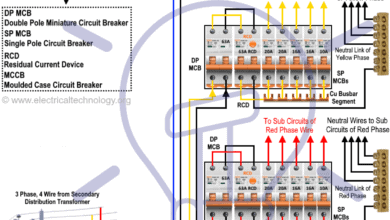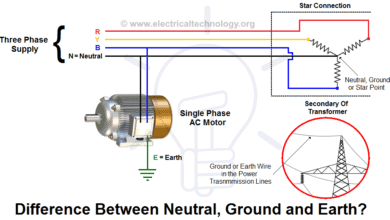Disadvantages of Low Power Factor
What are the Disadvantages of Low Power Factor (P.F)?
Power factor plays an important role in AC circuits as we know that power dissipation in three phase circuits
Power in a Three Phase AC Circuit = P = √3 V x I CosФ
And Current in a Three Phase AC Circuits = I = P / (3 V x CosФ)
I ∝1 / CosФ … (1)
Similarly,
Power in a Single Phase AC Circuits = P = V x I CosФ
And Current in a Three phase AC Circuits = I = P / (V x CosФ)
I ∝ 1/CosФ … (2)
It is clear from both equations (1) an (2) that Current “I” is inversely proportional to the CosФ i.e. Power Factor. In other words, When power factor increases, Current Decreases, and vice versa i.e. when Power Factor decreases, Current Increases.
Disadvantages and Effects of Low Power Factor
Now, In case of low power factor, current will be increased, and this high amount of current will lead to the following disadvantages.
Large Line Losses (Copper Losses):
We know that Line Losses is directly proportional to the squire of the electric current “I2”
Power Loss = I2 x R i.e., the larger the current, the greater the line losses i.e. I >> Line Losses
In other words,
Power Loss = I2 x R = 1 / CosФ2 … Refer to Equation “I ∝ 1/CosФ” … (1)
Thus, if Power factor = 0.8, then losses on this power factor =1/CosФ2 = 1/ 0.82 = 1.56 times will be greater than losses on Unity power factor.
Large kVA rating and Size of Electrical Equipment:
As we know that almost all Electrical Machinery (Transformer, Alternator, Switchgears etc) are rated in kVA. But, it is clear from the following formula that Power factor is inversely proportional to the kVA i.e.
Therefore, The Lower the Power factor, the larger the kVA rating of Machines also, the larger the kVA rating of Machines, The larger the Size of Machines and The Larger the size of Machines, The Larger the Cost of machines.
Greater Conductor Size and Cost:
In case of low power factor, current will be increased, thus, to transmit this high current, we need the larger size of conductor. Also, the cost of a large size of conductor will be increased.
Poor Voltage Regulation and Large Voltage Drop:
Voltage Drop = V = IZ.
Now in case of Low Power factor, Current will be increased. So the Larger the current, the Larger the Voltage Drop.
Also Voltage Regulation = V.R = (VNo Load – VFull Load)/ VFull Load
In case of Low Power Factor (lagging Power factor) there would be large voltage drop which causes low voltage regulation. Therefore, keeping Voltage drop in the particular limit, we need to install Extra regulation equipment i.e. Voltage regulators.
Low Efficiency:
In case of low Power Factor, there would be large voltage drop and large line losses and this will cause the system or equipment efficiency too low. For instance, due to low power factor, there would be large line losses; therefore, alternator needs high excitation, thus, generation efficiency as well as transformer’s efficiency would be low. Same is the case for lower motor’s efficiency in case of low P.F.
Penalty from Electric Power Supply Company on Low Power factor
Electrical Power supply Company imposes a penalty of power factor below 0.95 lagging in Electric power bill. So you must improve PF above 0.95.
Related Posts:
- What is Power Factor?
- Active, Reactive, Apparent and Complex Power
- Difference Between Active and Reactive Power – Watts vs VA
- Causes of Low Power Factor
- Power Factor improvement Methods with Their advantages & Disadvantages
- Advantages of Power factor improvement and Correction
- How to Calculate the Suitable Capacitor Size in µ-Farads & kVAR for P.F Improvement
- How to Convert Capacitor μ-Farads to kVAR and Vice Versa? – For P.F Correction
- Capacitor Bank in kVAR & µF Calculator for Power Factor Correction
- Power Factor Correction Calculator – How to Find P.F Capacitor in µF & kVAR?
- kVAR to Farad Calculator – How to Convert kVAR to μ-Farads?
- μ-Farad to kVAR Calculator – How to Convert Farads to kVAR?
- Analysis of Reactive Power in Power System
- Is Reactive Power Useful? Importance of Reactive Power
- Introduction of Custom Power Devices For Power Quality Improvement
- What is Static VAR Compensator (SVC)? Construction, Working and Applicators








What is the maximum resistance for a motor?
I lick it the whey do you explained it thanks guys
So understandable and helpful
thanks a lot for your information.